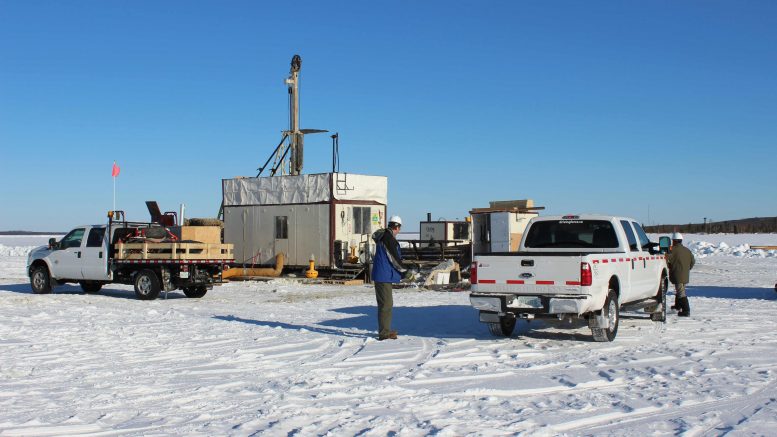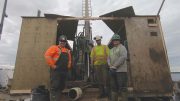In one of the few exploration projects it is funding next year, Cameco (TSX: CCO; NYSE: CCJ) and its joint-venture partners Orano Canada and Purepoint Uranium (TSXV: PTU) are planning a 36 km ground-electromagnetic survey and 6,000 metres of diamond drilling at their Hook Lake uranium project in Saskatchewan.
Cameco owns 39.5% of the project in the province’s Patterson uranium district, with Orano Canada holding 39.5% stake, and Purepoint, the operator, at 21%.
The 2019 winter drill program will see the partners continue to explore a mineralized shear zone that extends along the Patterson corridor. The shear runs through the project’s Dragon zone and is on trend with its Spitfire discovery.
The Patterson uranium district is a structural corridor situated on the southwestern edge of Saskatchewan’s Athabasca basin, which extends at least 50 km, and hosts Fission Uranium’s (TSX: FCU) Triple R deposit, NexGen Energy’s (TSX: NXE) Arrow deposit and Spitfire.
The Arrow and Triple R deposits are 7 km and 14 km southwest of Spitfire, and in the same geological structure that continues another 8 km through Spitfire to the northeast, and into Denison Mines’ (TSX: DML; NYSE-AM: DNN) ALX claims at its Hook-Carter project.
The $3-million exploration project planned for 2019 “speaks to Cameco’s feelings about the project,” says Chris Frostad, Purepoint’s president and CEO. “Majors don’t invest in exploration projects that don’t have the potential to be tier-one deposits, or more than 100 million lb. U3O8.”
The joint-venture partners are focusing exploration on an area between their high-grade Spitfire discovery of 2015 (53.3% U3O8 over 1.3 metres within a 10-metre interval assaying 10.3% U3O8, starting from 220 metres below surface), and the Dragon zone, 6 km northeast. Dragon was found at the end of 2016.
Spitfire sits on the southernmost claim line beside NexGen’s project. The Dragon area has an identical geological setting to Spitfire, Frostad says, only larger. “Not only that,” he adds, “but we could see that the structure running up from Triple R, through Arrow and into Spitfire appeared to connect directly through to Dragon. That area requires additional geophysical data to refine the targets, which is job one this season.”
Uranium doesn’t trade on an open market like many other commodities, so buyers and sellers negotiate contracts privately. Utilities buy their fuel under four to 10-year contracts to lock in the price.
The long-term price, which hasn’t changed in two years, is US$31 per lb., while the spot market price is now a little over US$28 per lb. U3O8.
Partly as a result, the market is tight and illiquid, a factor that has resulted in major price swings after major events, such as the Fukushima reactor meltdown in 2011, and accidents at Chernobyl (1986), Three Mile Island (1979) and the 1973 oil shock.
“There have been no significant long-term contracts signed in the last two years,” he says. “Why would a producer sign a new contract at US$30 to $35 per lb., when the marginal cost of production is US$40 per pound?
“They might if they were in trouble, but they’ve shut their mines down, laid everybody off, taken their whack — so they’re not going to give any deals if they don’t have to. They’re going to wait until the price comes back before they start turning things on.”

A worker in the core shack at Purepoint Uranium’s Hook Lake uranium project in northern Saskatchewan. Credit: Purepoint Uranium.
Cameco is buying a third of its product on the spot market because it’s cheaper than producing it, he says.
Meanwhile, uranium production continues to go down — currently it’s 16% lower than last year.
“What we’ve seen over the last two years is that supply has been forced to do a free fall. All excess inventory has driven uranium down to historic lows, and, as in other industries, we’ve seen mines shut down. And, in our case, a lot of contract buying has moved into the spot market. Because the spot price is so low you’ve got utilities buying on spot, rather than signing new contracts.”
But eventually, he argues, inventories will be soaked up and the price will turn.
“At the end of the day, nobody really knows what the inventory is. Half the planet won’t report what they’ve got. It would be around 1 billion lb., give or take, so nobody really knows at what point the inventory will get to before we start to see long-term contracts signed again.”
Like many in the industry, the mining executive is reluctant to guess when the sector will turn, but he says the tipping point could come soon.
“I’m thinking you’ll see the spot price meet up with the long-term price, probably at the end of the year,” he ventures. “Every time uranium moves it’s like an explosion, but I would think that by mid-2019, you’re going to see some real movement in the long-term price.

Purepoint Uranium’s exploration camp in Saskatchewan. Credit: Purepoint Uranium.
“If I’m a utility buyer, now it becomes: ‘I can either buy at spot at US$31.50 per lb., or I’m going to sign a contract,” he says. “So they’re going to hang on for as long as they dare, and they’re playing chicken. No one wants to be the first guy signing that new long-term contract.”
The market will have started to turn when you see the long-term price move back to profitable levels, he adds, and utilities “will have to pay whatever the price is, and I think you’ll see a jump from US$32 per lb. up to US$40 per lb. pretty quickly. Then people will start to ramp up again, because they’ll know things are heading in the right direction.”
Frostad argues that interest in uranium is greater than in other commodities “because investors recognize that they’re looking at a commodity at the bottom of its cycle. Everybody is waiting for the moment when it looks like it’s time to get back in.”
Nearly 80% of the world’s uranium is mined in four countries: Kazakhstan (39%), Canada (22%), Australia (10%) and Namibia (7%). (Niger produces 6%; Russia, 5%; and 11% comes from other smaller-scale producers.)
Saskatchewan’s known uranium resources have grades ranging from 1% to 20% — far in excess of anywhere else in the world.





Excellent article. Just a matter of time now. Inventories have always been opaque but the industry consumption is now well over 1 reactor years worth of fuel every single day and increasing. New reactors require three times the fuel inventory of a steady state reactor so those 54 plants being built are the fuel equivalent of 162 steady state plants and they are almost all coming on line in the next three years. After the first fuel load…ie the first refueling two thirds of the core is replaced. So these plants represent a very large initial Uranium demand that will mop up inventory quickly. With no new mines coming into production and most current mines with not very many years left in them prices MUST go up and they will (this time) stay much higher for much longer to provide producers with sufficient incentives.